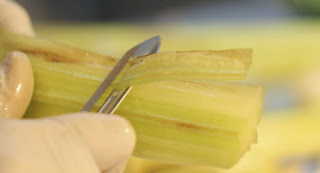The secret to making cardoons tender and sweet, a quick and easy fall recipe
“What is this?” asked the puzzled cashier at Publix holding up the cardoon I had found in the produce section. “Is it a kind of celery?” she asked. “Actually,” I replied, “it’s in the artichoke family”. In fact, cardoons taste very much like the best part of an artichoke. They are typically a late fall vegetable, and usually turn up around this time in our supermarket. I remember my mother used to make them when I was growing up. I was actually not very fond of them because they had a slightly bitter flavor. Of course, most children won’t like anything remotely bitter, but I’ve discovered how to eliminate that bitterness, and our kids, who love artichokes, also love cardoons.
First, choose the lightest colored cardoon, the greener it is, the more likely it will be bitter. Secondly, peel the back of the stalks before cooking them. Be careful, because a cardoon is a thistle, and just like an artichoke it has thorns, albeit quite small. They are located on the edges of the stalks and need to be trimmed. Also, cardoons need to boil 30-40 minutes until very tender.
Once cooked, they can be gratinéed, as in the recipe below, or simply dressed with some salt, olive oil, and red wine vinegar and served cold.
Gratinéed Cardoons
From How to Cook Italian by Giuliano Hazan
Preparation time: 15 minutes
Total time from start to finish: 45 minutes
Serves 6 as a side dish
1 cardoon
Salt
1 1/2 tablespoons butter
1/4 cup freshly grated Parmigiano-Reggiano
1. Fill a pot with at least 6 quarts of water, place over high heat and bring to a boil.
2. Separate the stalks of the cardoon from the heart and trim away any leaves. Cut off a sliver from the top and bottom of each stalk. Use a vegetable peeler to peel the backs of the stalks to remove the outer layer of skin and any tough strings. Trim the heart so only the white inner part remains. Cut the stalks into 6-inch long pieces and rinse in cold water.
3. Add 1 tablespoon of salt to the boiling water and put in the cardoon. Cover the pot and boil until tender, 30-35 minutes.
4. Preheat oven to 425° on the convection setting, or to 450° on regular bake.
5. Drain the cardoon and place in a baking dish in a single layer. Season with salt dot with the butter, and sprinkle the Parmigiano-Reggiano on top. Bake until the cheese melts and just begins to brown, 10-15 minutes. Serve hot.
Original posted on http://giulianohazan.com/the-secret-to-making-cardoons-tender-and-sweet-a-quick-and-easy-fall-recipe/


